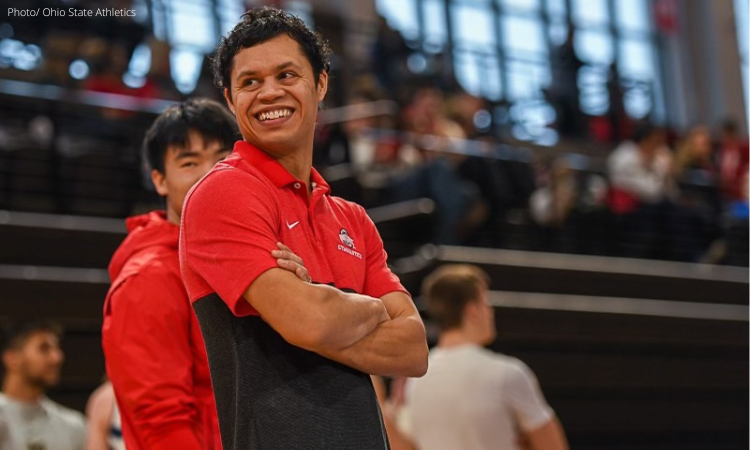At first glance, the Venn diagram of transferable skills between a Studio Arts degree and being an NCAA gymnastics coach may give off two solitudes. If you ask Ohio State’s men’s assistant coach Jamie Henderson, communication skills and creativity are a big part of the overlap.
When Henderson initially signed to compete for Oklahoma as a freshman in the 2002 season, the rule of coaches contacting high school juniors or older hadn’t been introduced yet. He had committed long before knowing what he wanted to study, with gymnastics guiding how he chose a school. His interest in architecture as a teenager initially led him to want to pursue it as an undergrad, but with scheduling around gymnastics in mind, he instead found his way into the Studio Art program. He’d “gravitated toward it,” leaning into the process in foundation courses and studio work. The connections between his two worlds became apparent almost instantly in Norman, with his curiosity around architecture translating well to studying the human form in the studio.
“I’ll go to the gym, try to focus on my gymnastics, and then at the same time get images locked in my memory, and then go back to the studio and use that in my work there”, said Henderson about having balanced his two focuses. Time management skills also came in handy, having learned them while completing high school at home before honing them in university. He often worked backward from the set dates of team practices and events, then filled in spaces with studio work. Though no art student is immune to late studio nights, Henderson maintains that his professors were glad to assist in maintaining his schedule. His attention to time management paid off, amassing three NCAA team titles with the Sooners.
Aside from the physical creation of artwork, Studio Art students spend an almost equal amount of time learning how to provide and facilitate meaningful critiques. A strong artist is able to not only create work that evokes specific intended responses, but it’s also able to guide conversations about a piece in the way they want. If you think this sounds similar to coaching athletes, Jamie would agree. To him, guiding athletes through troubles with a skill is no different than discussing art, aside from the subject matter. Both go through the process of “looking from different angles, stepping back and getting in close… it’s the same process as getting a fresh new look at your work – your sculpture, painting, whatever you’re doing and just see it from a different angle and in different lights”, on his account.
When problem solving as a coach, he relies on his skillset formed in studio critiques. Coaching at the D1 level, his coaching strength is in explaining to his younger athletes. Being able to communicate in a way that a gymnast can break down and process feedback is key, and is different for each Buckeye. A big part of this process for him is asking his gymnasts what they feel during a skill, “because if you are real sensitive to it, you can manipulate and control your gymnastics even better”. Talking through how the skill feels isn’t as conventional as a cue to be tighter in the air, but this shift in perspective can sometimes be the missing ingredient to make skills safer.
From there, the artistry of the sport can shine through. The connection between all six men’s events is apparent in his coaching philosophy. He advocates for that link, and tries to tie each event together: “The presentation that everyone can see right off the top from floor – they’re the same, in terms of just movement on the other events”. While floor may get the reputation for being flashy to casual gymnastics fans, performance quality is everywhere to Henderson.
At the end of the day, the Big Ten is a hotbed for big names in the sport. The subtle differences in how art shaped Jamie Henderson’s coaching is apparent in the Buckeyes’ movement quality and learning structures. Put as simply as possible, he sees the art in men’s artistic gymnastics.
READ THIS NEXT: GymACT and the Growth of Men’s Collegiate Gymnastics
Article by Peri Goodman
Like what you see? Consider donating to support our efforts throughout the year! [wpedon id=”13158″]





One comment